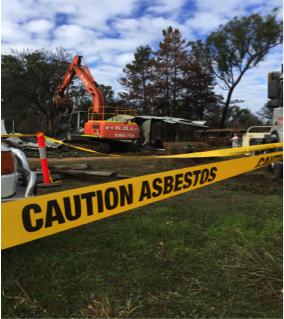Wye River bushfire clean up: Environmental monitoring and validation
Summary of works
The bushfire on Christmas Day of 2015 destroyed a total of 116 houses in Wye River and Separation Creek.
Grocon was appointed by the State Government to manage the clean up works at Wye River and Separation Creek and commenced the assessment and prioritisation of properties in February 2016.
ESG Environmental Pty Ltd (ESG) was engaged by Grocon to oversee and conduct the environmental monitoring and validation works associated with the bushfire clean up. ESG commenced the pre inspections of the properties in March 2016.
The pre clearance visual inspection was completed for all registered properties in Wye River and Separation Creek prior to any demolition works commencing with the aim of visually assessing the presence of potential asbestos containing materials, other hazardous materials or any stained or odourous soils which would require specific management or controls during the clean up works. Properties not affected by the fires were also inspected, as it was possible for debris to be present from neighbouring properties that were affected.
Air monitoring for asbestos was conducted for each work area during the waste removal to confirm that the dust/airborne fibre suppression methods were adequate for worker protection and to provide reassurance that undamaged buildings within and near work areas were not a repository for dust and fibres. These were set up down wind of the work zone. Air monitoring for asbestos was also completed on a daily basis at a number of “unaffected” areas to monitor background levels and ensure potential fibres had not been transported to worker’s lunch rooms or to the neighbouring café at Wye River.
During the waste removal process, any material such as concrete and steel that was deemed not to have sustained significant fire damage and assessed as being suitable for recycling was washed and also inspected by ESG, and a certificate issued prior to being transported.
Machinery used on each property was also washed and inspected by ESG prior to mobilisation to the next property to prevent cross contamination between properties. Machine clearance certificates were also issued by ESG.
Once a property was deemed to meet the clean-up standard, an inspection was completed by the ESG hygienist to verify that all burnt debris or waste had been removed and that there was no visible evidence of soil contamination. If the site inspection revealed a necessity for additional clean up work, Grocon were notified to arrange further works and re-verification of the property was conducted by ESG upon completion.
ESG then issued Grocon with the Waste Cleanup Clearance Certificate to demonstrate clean-up and air monitoring for asbestos were completed on each property as a final clearance to confirm removal of all potential airborne asbestos fibres.
Project highlights
Client: Grocon
Client contact: Robert Galle
Duration: March – August 2016
Specific issues / problem solving
Potential unknown hazardous materials and conditions
Coordination of environmental monitoring and validation in conjunction with other site works in a timely and safe manner
Ensuring adequate air monitoring for potential asbestos fibres
Conducting work safely in unfavourable environmental conditions, i.e steep, denuded terrain and adverse weather
Conducting works to ensure safety and protect health
Key services
Providing preliminary site inspections to assess for the presence of asbestos and other potential environmental hazards such as chemical and other hazardous wastes
Monitoring for asbestos fibres in air during the bushfire waste removal and demolition program
Conducting post-clean up site validation inspections, including issuing of clean-up verification documentation and certificates
Providing adhoc assistance on both environmental and safety matters for the works and development of audit protocols and procedures to be adopted by Grocon for all of the sites where bushfire waste debris is to be removed.
Benefits
Pre inspections to identify and assess potential health risks
Air monitoring at individual properties where removal works were being conducted and also in bulk material handling areas
Post clean up site inspections to ensure satisfactory clean up and no remaining hazardous waste and material
Recyclable material inspections to ensure adequate washing of building wastes such as concrete and steel proposed for recycling
Overall works were completed to reduce environmental dangers and risks to ensure recovery and help home owners return to normality.

